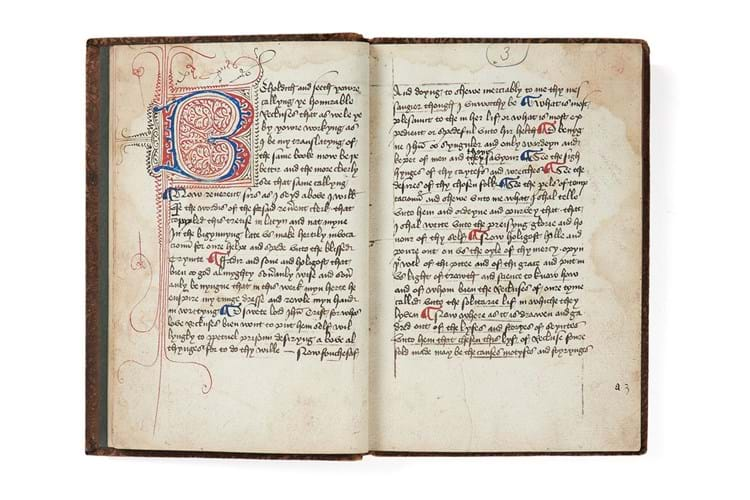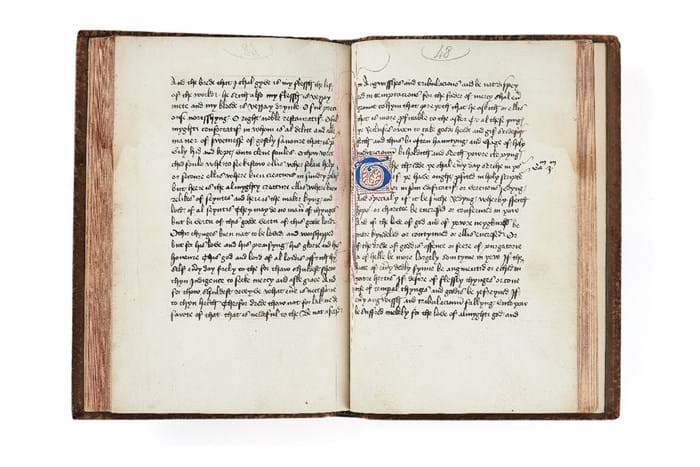
The Mirror of Recluses (The Myrowr of Recluses) is believed to be the only complete copy of a 15th century Middle English translation of the Latin rule for recluses, Speculum Inclusorum.
The manuscript became known to scholars in 2014 and includes substantial amounts of text that are missing from the only other extant copy (now in the British Library) and begins with a previously unknown translator’s prologue.
It was sold at Bloomsbury Auctions in central London on July 2, 2019, and the Department for Digital, Culture, Media and Sport (DCMS) is asking a buyer to match the £168,750 paid (£135,000 hammer price plus fees).
The manuscript was formerly in the collection of the British Liberal politician Allan Heywood Bright (1862-1941) and then sold by his descendants at Christie’s on July 16, 2014.
The minister’s decision to temporarily block its export follows the advice of the Reviewing Committee on the Export of Works of Art and Objects of Cultural Interest (RCEWA) which made its recommendation on the grounds of the manuscript's outstanding significance for the study of collecting history, the medieval book trade and the history of anchoritic life in England.
The manuscript is believed to have been written in the early 1400s in London by an unknown scribe. It has been suggested that the copy was produced in Barking Abbey as part of the female education campaign of Abbess Sybil de Felton in the first half of the 15th century.
It is designed to be a guide for anchorites or hermits who were religious recluses that retreated from society in order to dedicate their lives to prayer and contemplation.
It is estimated that there were around 200 anchorites or hermits in England in the 13th century with more women entering the life than men. However, there is little evidence as to how many were living at the time the manuscript was written.
The only other known version is an incomplete manuscript held by the British Library which dates from the mid-15th century. The discovery of the manuscript at risk of export has revealed previously unknown sections of the text and is of huge significance for the study of the lives of medieval women and anchorites.

This copy of 'The Mirror of Recluses' (The Myrowr of Recluses) has been suggested to have been produced in Barking Abbey as part of the female education campaign of Abbess Sybil de Felton in the first half of the 15th century.
Leslie Webster, a RCEWA committee member, said: “Unknown to scholarship until recently, this handsomely decorated copy of a guide to the austere life of an anchorite offers a rich new avenue of exploration into the nature of women’s religious education in the early 15th century, and how such texts were circulated.
“Almost certainly written for female anchorites, the text seems to be linked to the Benedictine nuns at Barking Abbey, a foundation dating back to Anglo-Saxon times, and in the 15th century, renowned as a house of educated women, inspired by its abbess, Sybil de Felton.
“Amongst other unique content, this particular manuscript also gives a precise date for the beginning of the text’s composition: ‘this Wednysday bi the morrow, the even of the blissed virgyne seynt Alburgh, the secunde yeere of the worthy christen prince oure souerayn liege lord the kyng Henry the Fiftis’ – or Wednesday, October 10, 1414. Such contemporary detail makes the manuscript a vivid witness to the period, as well as of great importance to our understanding of later medieval thought and society. It is a fascinating treasure that deserves to be saved.”
The decision on the export licence application for the manuscript will be deferred until April 13, 2020. This may be extended until August if a serious intention to raise funds to purchase it has been made.





